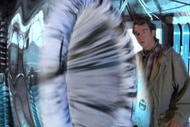Create a free profile to get unlimited access to exclusive videos, sweepstakes, and more!
TV anthologies are gloomy. That’s why Tales from the Loop's earnestness will throw you for a loop

The history of the anthology series is steeped in dark twists, cynicism, and delightful cruelty. The Twilight Zone had a lighter, happier side, of course, but what do you remember from the show? It’s bookworm Burgess Meredith breaking his glasses in the apocalypse or the alien cookbook in “To Serve Man.”
From the old days of The Twilight Zone and Outer Limits to staples of the ‘80s like Tales From the Crypt, Tales From the Darkside, and Monsters, and even more recently with Black Mirror, the default setting for TV genre has always been dark, dark, and darker.
Now Amazon Prime’s Tales From the Loop comes along and bucks that trend at a time when audiences could use a bit of earnestness — maybe even some outright positivity. The show is set in a fictional Ohio town that’s built on top of a mysterious invention that can mess with time, space, and reality. That opens the door for many interconnected stories between the perplexed townspeople. Things can get complicated when messing with reality, to say the least, but the uncertainty is eased by Tales From the Loop’s willingness to wear its heart on its sleeve.
“I wanted to use the genre to tell stories that were poignant and had some hope in them and that the technology and science fiction scenarios actually served to create connection and emotion versus something that alienated you or made you feel scared,” series creator Nathaniel Halpern tells SYFY WIRE. “It really was that kind of direct approach to the genre. I just wanted to tell emotional stories because I don’t really see much anymore that are poignant and not jaded or cynical.”
He adds that while there’s obviously room for darker material in the genre, not everything has to remind us how horrible things can be, a sentiment echoed by his cast. Paul Schneider, who plays George, the son of the mastermind who invents the tech this town rests on top of, says that he feels cynicism is often used as a means of being taken seriously. The darker and more cruel the story is, the more “important” the work is considered.
“I feel like Tales From the Loop leans into the human emotion and desire for human connection,” Schneider says. “I like that fact that science fiction in general is the key that unlocks human stories, about family and secrets and love and failure and rebirth. Nathaniel called the series ‘an empathy delivery vehicle,’ and I really responded to that.”
That doesn’t mean the Amazon series is cloyingly sweet. Far from it, in fact. The show deals with heavy material, like mortality, legacy, and the complications that come with familial love, and does so from an often bittersweet point of view. It’s something that jumped out for series star Rebecca Hall from her very first read of the pilot.
“It was incredibly moving whilst also being quite indirect,” Hall says. “I didn’t find it to be sentimental or too on the nose or any of these things that I have a lot of problems with. I found it incredibly moving and also really about something significant and mysterious, and it had a very strong stylistic sensibility.”
“My goal was certainly to tell a story that was emotional and poignant, but not sentimental, and I think people respond to that honesty,” Halpern adds. “I feel like they’d pull away if that didn’t emotionally resonate. You have to be willing to endure some of that sadness to recognize, ‘Yeah, that feels true.’ Then you provide a little bit of comfort after, and I think that’s where the emotional impact comes from that I strive for in the show.”
Halpern created this sci-fi series using the work of Swedish artist Simon Stalenhag as a jumping-off point. Stalenhag’s digital paintings offered a grounded look at what science fiction could look like in the real world; his robots are aged and as much a part of rural landscapes as modern-day tractors.
That aesthetic spoke to Halpern and set the tone for this series from the very beginning. He cites a certain humanity in the rundown robots on display, a poignancy that you wouldn’t find in a shiny, overly designed, brand-new bit of tech.
While the paintings don’t tell a direct story to adapt, Halpern could sense a “loose narrative” that intrigued him.
“The worlds he created in those paintings I used as visual prompts to create stories and the world of the show as you see it,” Halpern says. “On that level it is a rather unique series that’s very visually driven, going from one visual medium to another.”
Part of his pitch for the show was to capture that vibe as cinematically as possible. It must have worked, because on top of the impressive cast — including Hall, Schneider, and heavyweight Jonathan Pryce (Game of Thrones, The Two Popes) — Halpern also got a who’s who of directing talent involved: Mark Romanek and Andrew Stanton came to play in this world, and Matt Reeves helped produce it.
While the production value of the show is obviously very high, it’s still the beating, human heart at the center of this universe that proves to be the ultimate draw. The science fiction elements are great, but without humanity at its core, the story doesn’t have the same draw.
Schneider compares the approach to Tales From the Loop with genre favorites like The Lord of the Rings or E.T. They both tell insane stories and immaculately build a new, fantastic world, but if you don’t care about the hobbits going off to deal with the ring or feel E.T.’s homesickness then none of that matters. There’s gotta be something deeper.
“Ultimately, what he’s dealing with is that the basic problem with being a human is time,” Hall adds. “If it weren’t for time, then when we were happy we’d stay happy and we wouldn’t ever be abandoned and relationships wouldn’t ever break down and we wouldn’t all die. It’s so human, and it gets you in your emotional core, this basic concept. That’s what this whole show is basically dealing with.”
Tales From the Loop debuts on Amazon Prime on Friday, April 3.




























